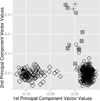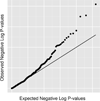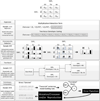Statistical Optimization of Pharmacogenomics Association Studies: Key Considerations from Study Design to Analysis
- PMID: 21887206
- PMCID: PMC3163263
- DOI: 10.2174/187569211794728805
Statistical Optimization of Pharmacogenomics Association Studies: Key Considerations from Study Design to Analysis
Abstract
Research in human genetics and genetic epidemiology has grown significantly over the previous decade, particularly in the field of pharmacogenomics. Pharmacogenomics presents an opportunity for rapid translation of associated genetic polymorphisms into diagnostic measures or tests to guide therapy as part of a move towards personalized medicine. Expansion in genotyping technology has cleared the way for widespread use of whole-genome genotyping in the effort to identify novel biology and new genetic markers associated with pharmacokinetic and pharmacodynamic endpoints. With new technology and methodology regularly becoming available for use in genetic studies, a discussion on the application of such tools becomes necessary. In particular, quality control criteria have evolved with the use of GWAS as we have come to understand potential systematic errors which can be introduced into the data during genotyping. There have been several replicated pharmacogenomic associations, some of which have moved to the clinic to enact change in treatment decisions. These examples of translation illustrate the strength of evidence necessary to successfully and effectively translate a genetic discovery. In this review, the design of pharmacogenomic association studies is examined with the goal of optimizing the impact and utility of this research. Issues of ascertainment, genotyping, quality control, analysis and interpretation are considered.
Conflict of interest statement
None declared/applicable
Figures









Similar articles
-
The future of Cochrane Neonatal.Early Hum Dev. 2020 Nov;150:105191. doi: 10.1016/j.earlhumdev.2020.105191. Epub 2020 Sep 12. Early Hum Dev. 2020. PMID: 33036834
-
Pharmacogenomics of chemotherapeutic susceptibility and toxicity.Genome Med. 2012 Nov 30;4(11):90. doi: 10.1186/gm391. eCollection 2012. Genome Med. 2012. PMID: 23199206 Free PMC article. Review.
-
Folic acid supplementation and malaria susceptibility and severity among people taking antifolate antimalarial drugs in endemic areas.Cochrane Database Syst Rev. 2022 Feb 1;2(2022):CD014217. doi: 10.1002/14651858.CD014217. Cochrane Database Syst Rev. 2022. PMID: 36321557 Free PMC article.
-
Pharmacogenomics: Current State-of-the-Art.Genes (Basel). 2014 May 26;5(2):430-43. doi: 10.3390/genes5020430. Genes (Basel). 2014. PMID: 24865298 Free PMC article.
-
Design considerations for genetic linkage and association studies.Methods Mol Biol. 2012;850:237-62. doi: 10.1007/978-1-61779-555-8_13. Methods Mol Biol. 2012. PMID: 22307702
Cited by
-
Identification of ITGA2B and ITGB3 Single-Nucleotide Polymorphisms and Their Influences on the Platelet Function.Biomed Res Int. 2016;2016:5675084. doi: 10.1155/2016/5675084. Epub 2016 Nov 14. Biomed Res Int. 2016. PMID: 27965976 Free PMC article.
-
Concept of pharmacogenomics and future considerations.CNS Neurosci Ther. 2013 Oct;19(10):842-4. doi: 10.1111/cns.12157. Epub 2013 Aug 7. CNS Neurosci Ther. 2013. PMID: 23919514 Free PMC article. Review. No abstract available.
-
Cancer pharmacogenomics: strategies and challenges.Nat Rev Genet. 2013 Jan;14(1):23-34. doi: 10.1038/nrg3352. Epub 2012 Nov 27. Nat Rev Genet. 2013. PMID: 23183705 Free PMC article. Review.
-
Pharmacogenomics in early-phase clinical development.Pharmacogenomics. 2013 Jul;14(9):1085-97. doi: 10.2217/pgs.13.81. Pharmacogenomics. 2013. PMID: 23837482 Free PMC article. Review.
-
The success of pharmacogenomics in moving genetic association studies from bench to bedside: study design and implementation of precision medicine in the post-GWAS era.Hum Genet. 2012 Oct;131(10):1615-26. doi: 10.1007/s00439-012-1221-z. Epub 2012 Aug 25. Hum Genet. 2012. PMID: 22923055 Free PMC article. Review.
References
-
- Lazarou J, Pomeranz BH, Corey PN. Incidence of adverse drug reactions in hospitalized patients: a meta-analysis of prospective studies. JAMA. 1998;279(15):1200–1205. - PubMed
-
- Collins FS, Guyer MS, Charkravarti A. Variations on a theme: cataloging human DNA sequence variation. Science. 1997;278(5343):1580–1581. - PubMed
Grants and funding
LinkOut - more resources
Full Text Sources
